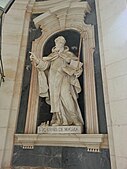Filippo della Valle

Filippo della Valle (26 December 1698 – 29 April 1768) was an Italian late-Baroque or early Neoclassic sculptor, active mostly in Rome.
Biography
Della Valle was born in Florence.
Initially apprenticed with
Academy of St Luke together with Pietro Bracci, and was later to become the director or Principe of that group. In Rome, he worked with Bracci on Nicola Salvi's Trevi Fountain
, where he completed the allegorical statues of Health and Abundance.
Della Valle masterpiece is his Annunciation relief (1750) for the church of
Pierre Legros the Younger's handling of the relief depicting St Aloysious Gonzaga in Glory (1698), which stands across from Della Valle's Annunciation in Sant'Ignazio.[1]
In 1750, he completed a funerary monument to Manuel Pereira de Sampaio, Portuguese ambassador to the Holy See, in the Church of Sant'Antonio dei Portoghesi.
He also completed the statue of Temperance (1734) in the Corsini Chapel at
Santa Susanna. In this chapel, della Valle, working with Maini, shows the influence of the Florentine Massimiliano Soldani Benzi. In style, della Valle was allied to the rising group of French sculptors in Rome including Michelangelo Slodtz
.
He also completed the monument for
St Peter's Basilica
.
He died in Rome and was buried at Santa Susanna.
Works
-
Abundance, Trevi Fountain, Italy
-
Health, Trevi Fountain, Italy
-
Saint John of Matha, Basilica ofMafra National Palace, Portugal
-
Saint Teresa of Ávila,Saint Peter's Basilica, Vatican
-
Innocent XII's monument, St Peter's Basilica
Sources
Wikimedia Commons has media related to Filippo della Valle.
- Bruce Boucher (1998). Thames & Hudson, World of Art (ed.). Italian Baroque Sculpture. pp. 169, 208–209.
- Web Gallery of Art
- ^ Boucher, page 170.





